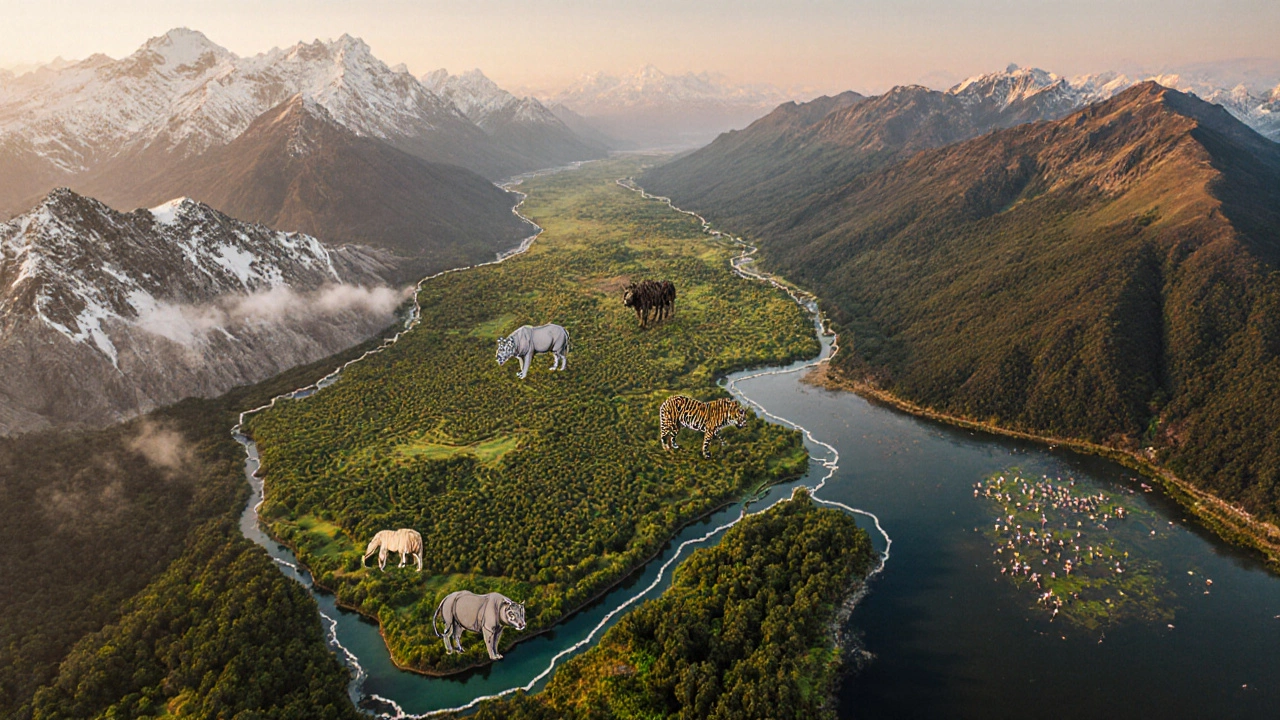India's Natural Heritage Sites Explorer
Explore India's seven UNESCO natural heritage sites with this interactive tool. Filter sites by state, ecosystem type, or key characteristics to plan your visit.
India’s landscape is a patchwork of towering mountains, sprawling wetlands, dense forests, and coastal mangroves, each home to unique life forms. Natural heritage sites in India are the UNESCO‑inscribed areas that showcase the country’s extraordinary biodiversity, geological wonders, and cultural‑environmental links. As of 2025 there are exactly seven such sites, each a living museum of nature’s brilliance.
Quick Takeaways
- Seven UNESCO natural heritage sites span from the Himalayas to the Sundarbans.
- They protect iconic species like the one‑horned rhinoceros, Bengal tiger, and snow leopard.
- All sites are open to visitors, but each has specific guidelines to protect fragile ecosystems.
- Conservation efforts rely heavily on community participation and sustainable tourism.
- Knowing the inscription year, location, and key attractions helps you plan a focused itinerary.
What Makes a Site a Natural Heritage Site?
UNESCO’s World Heritage Convention defines a natural heritage site as an area that contains outstanding natural phenomena, geological formations, or habitats of threatened species. The site must meet at least one of criteria (vii)-(x) - ranging from superlative natural beauty to ecological and biological processes. In India, the seven sites all satisfy these strict standards, earning global recognition and protection.
The Seven Natural Heritage Sites
1. Kaziranga National Park
Kaziranga National Park is a sprawling wildlife sanctuary in Assam, famous for hosting over two thirds of the world’s great‑one‑horned rhinoceros population. Inscribed in 1985, the park spans 1,430 km² of tall grasslands, wetlands, and forest. Apart from rhinos, you’ll spot elephants, tigers, and over 500 bird species, making it a bird‑watcher’s paradise.
2. Manas National Park
Manas National Park lies on the foothills of the Eastern Himalayas in Assam, bordering Bhutan. Recognized by UNESCO in 1985, Manas is a UNESCO World Heritage Site that also earned a spot on the List of World Heritage in Danger for a decade. Its mosaic of riverine grasslands, dense forests, and alpine meadows shelters the endangered hispid hare, golden langur, and the Assam roofed turtle.
3. Sundarbans National Park
Sundarbans National Park covers the Indian side of the world’s largest mangrove forest, straddling West Bengal and Bangladesh. Inscribed in 2001, this UNESCO site is a tidal maze of creeks, islands, and mudflats, famed for the Bengal tiger’s unique “river‑tiger” behavior. The mangroves also support the proboscis monkey, estuarine crocodile, and numerous fish that sustain local livelihoods.
4. Nanda Devi and Valley of Flowers National Parks
Nanda Devi and Valley of Flowers National Parks sit high in Uttarakhand’s Garhwal Himalaya. Combined as a single UNESCO property in 2010, Nanda Devi (7,816 m) is a pristine alpine biosphere, while the adjoining Valley of Flowers bursts into colour with over 500 alpine flower species each monsoon. The area is a haven for snow leopards, Himalayan musk deer, and rare butterflies.
5. Great Himalayan National Park
Great Himalayan National Park lies in Himachal Pradesh, covering 765 km² of rugged mountain terrain. Added to UNESCO’s list in 2014, the park protects 15 major biomes, ranging from sub‑tropical pine forests to alpine meadows. Iconic wildlife includes the Himalayan brown bear, blue sheep, and over 200 bird species.
6. Western Ghats
Western Ghats stretch along India’s western coastline for 1,600 km, spanning six states. Declared a UNESCO World Heritage Site in 2012, this mountain range is a biodiversity hotspot with more than 7,000 plant species, 500 bird species, and 300 amphibian species - many of them endemic. Its waterfalls, tea estates, and shola forests attract trekkers and nature lovers alike.
7. Keoladeo National Park
Keoladeo National Park (also known as Bharatpur Bird Sanctuary) sits in Rajasthan’s semi‑arid zone. Inscribed in 2015, the park encompasses 29 km² of marshes, lakes, and grasslands. It hosts over 370 bird species, including the endangered Siberian crane and the Indian flamingo, making it a premier destination for ornithologists.

Side‑by‑Side Comparison
| Site | UNESCO Inscription Year | State / Union Territory | Signature Species | Primary Ecosystem |
|---|---|---|---|---|
| Kaziranga National Park | 1985 | Assam | One‑horned Rhinoceros | Grassland & Wetland |
| Manas National Park | 1985 | Assam | Golden Langur | Riverine Forest & Grassland |
| Sundarbans National Park | 2001 | West Bengal | Bengal Tiger | Mangrove Swamp |
| Nanda Devi & Valley of Flowers | 2010 | Uttarakhand | Snow Leopard | Alpine Meadow & Glacial |
| Great Himalayan National Park | 2014 | Himachal Pradesh | Himalayan Brown Bear | Temperate Forest & Alpine |
| Western Ghats | 2012 | Maharashtra, Karnataka, Kerala, Tamil Nadu, Goa, Gujarat, and Daman & Diu | Malabar Pied Hornbill | Evergreen Montane Forest |
| Keoladeo National Park | 2015 | Rajasthan | Siberian Crane | Freshwater Wetland |
Visiting Tips & Conservation Challenges
Each site offers a distinct experience, yet they share common responsibilities for travelers:
- Plan ahead: Most parks require permits, guided tours, or entry fees. Book a few weeks in advance, especially for high‑traffic periods like the monsoon in the Valley of Flowers.
- Stay on marked trails: Straying can damage fragile alpine flora or disturb nesting birds in Keoladeo.
- Pack responsibly: Use reusable water bottles, avoid single‑use plastics, and carry biodegradable soap.
- Respect wildlife: Keep a safe distance, never feed animals, and silence your camera flash in tiger‑rich zones like the Sundarbans.
From a conservation standpoint, the biggest threats remain habitat loss, climate change, and illegal poaching. Community‑led initiatives-such as the “Rhino Patrol” in Kaziranga and “Mangrove Restoration” projects in the Sundarbans-show how locals can protect their heritage while earning livelihoods.

How You Can Help Preserve These Treasures
- Support certified eco‑tour operators who channel a portion of revenue back to park management.
- Donate to NGOs like the Wildlife Trust of India, which runs anti‑poaching squads in Manas and Kaziranga.
- Participate in citizen‑science apps (e.g., iNaturalist) to record species sightings, helping scientists track biodiversity trends.
- Advocate for sustainable policies-write to local representatives or sign petitions protecting the Western Ghats from mining.
- Educate yourself and others about the cultural ties many indigenous communities have with these landscapes; respectful tourism nurtures that bond.
Frequently Asked Questions
When were India’s natural heritage sites first inscribed by UNESCO?
The first two-Kaziranga and Manas National Parks-were added in 1985. The most recent addition is Keoladeo National Park, inscribed in 2015.
Can I visit all seven sites in a single trip?
Logistically it’s tough because they span from the Himalayan north to the southern coast. Most travelers pick 2‑3 sites that fit a regional itinerary-e.g., a north‑east loop covering Kaziranga, Manas, and Sundarbans.
Do I need a special permit to enter the Sundarbans?
Yes. Visitors must book a licensed boat tour from Kolkata or Sundarbans entry points, and a wildlife permit is issued on the spot. Solo trekking without a guide is not allowed.
Which site has the highest bird diversity?
Keoladeo National Park tops the list, with over 370 recorded bird species, making it a premier bird‑watching destination.
Are there any danger zones or restricted areas?
Yes. Core zones in Kaziranga, Manas, and the Great Himalayan NP are off‑limits to tourists to protect breeding grounds. Always respect signage and ranger instructions.
Exploring India’s seven natural heritage sites is more than a travel checklist-it’s an invitation to witness the planet’s most vibrant ecosystems and to play a part in keeping them alive for generations to come.
